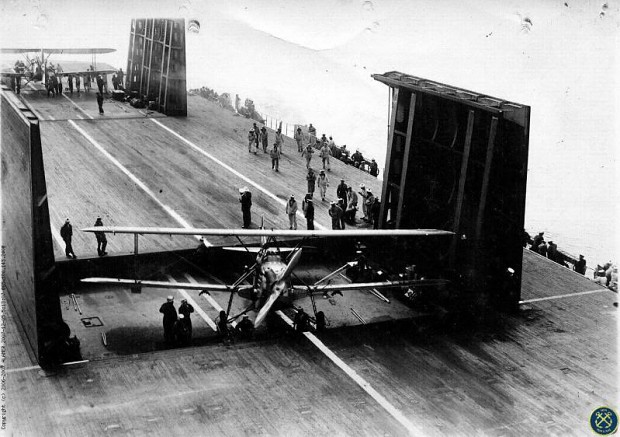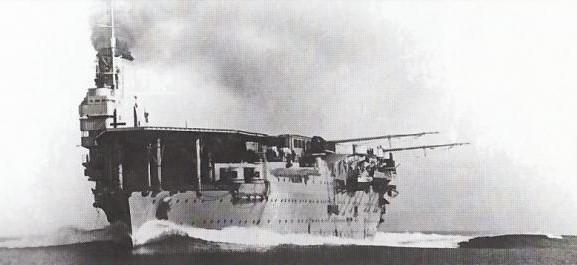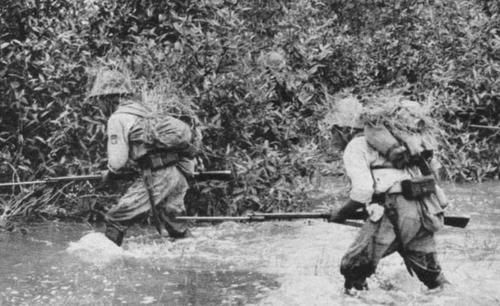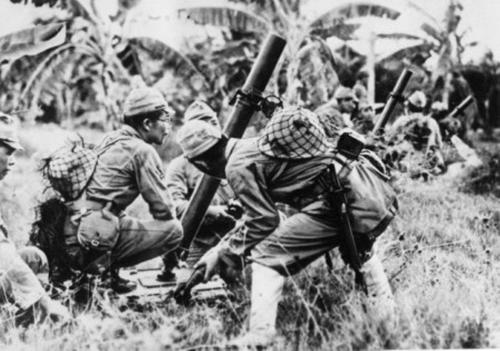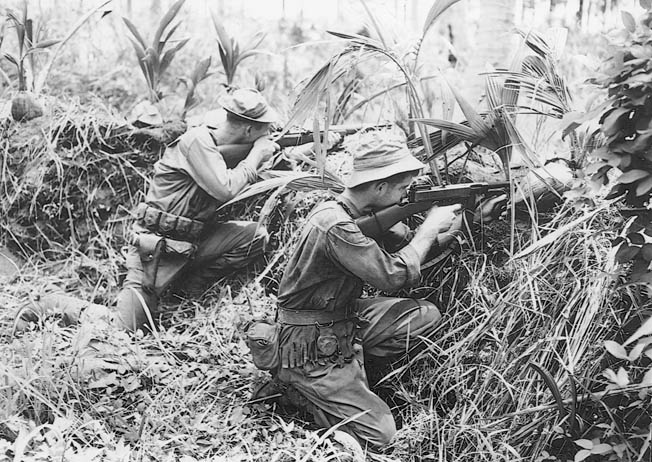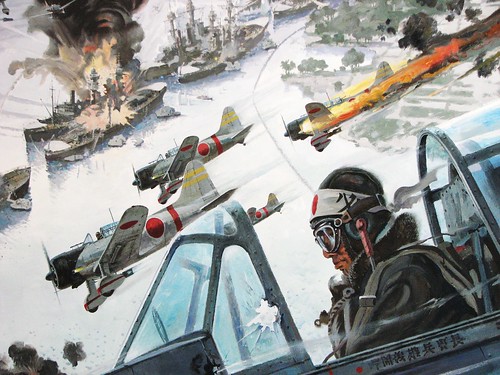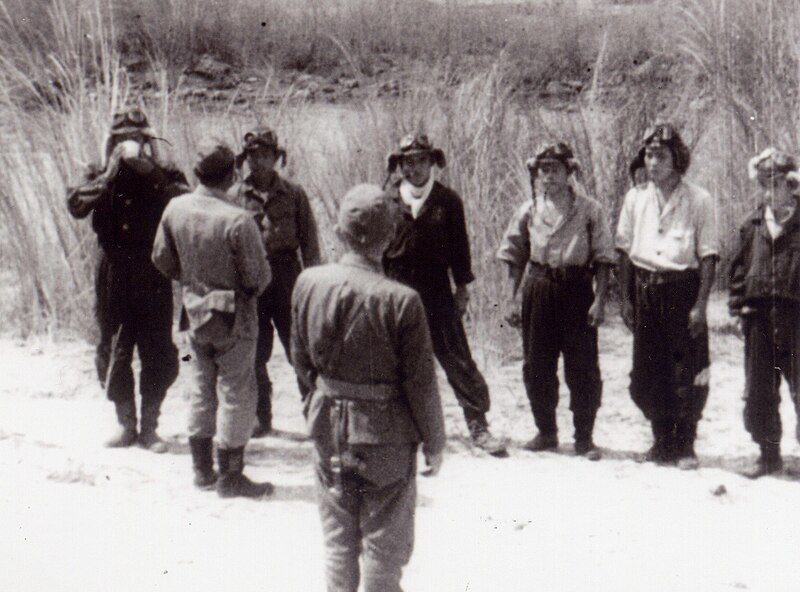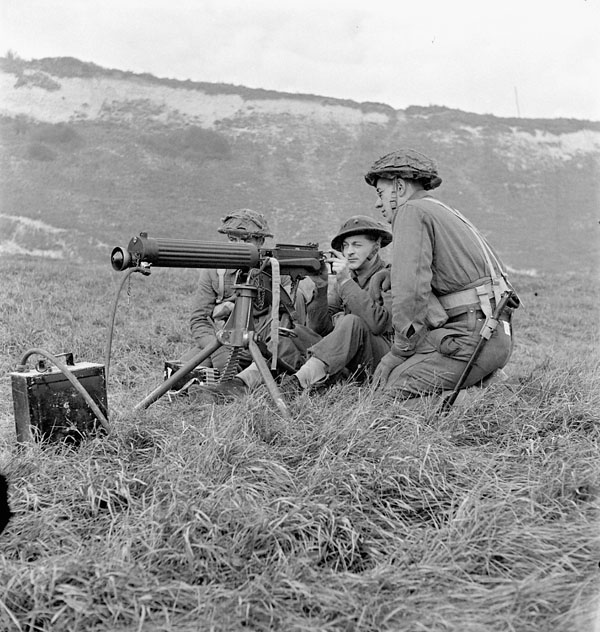Chapters 353: Lessons learned at Midway: Anti-aircraft Upgrades
Chapters 353: Lessons learned at Midway: Anti-aircraft Upgrades

After Coral Sea and Midway, the Imperial Japanese Navy realized that it was time to refit it's older AA guns for more efficiency in future battles. The older AA guns such as 8 cm/40 3rd Year Type naval gun and 12 cm/45 10th Year Type naval guns were replaced with Type 89 12.7 cm (from 1929) would be replaced with the 25 mm Type 96 AA guns (from 1936), a locally-built variant of the French Hotchkiss 25mm anti-aircraft gun. Previous Type 96 AA guns will be replaced by the 100mm/10 cm Type 98 naval gun (from 1938) as well as the new 40 mm Type 02, a locally-built variant of the Swedish Bofors 40 mm gun (in the variation QF 40 mm Mark III captured in Singapore, as well as those build into National Han Chinese Ships build since 1942, but only put in mass use for the Navy later, during 43/44, when the produced equipment had the needed numbers). It was also made a new standart, that every (land- and ship based) AA of this types had from now on be twin mounted inside the Co-Prosperity Sphere at least. In reality at least the Imperial Japanese Navy however favored a triple and quadruple (in 1944 when many double or triple AA versions were changed once again for more moddern versions) mounted AA version after Midway.
Most of the Type 96 25mm AA mounts would be tripled or at least doubled, during this conversion. They were placed in a manner that astern, port, abead and starboard and even additional fire control directors were added. For the Yamato-class (Yamato and Musashi) it's 8 x Triple Enclosed Type 96 25 mm Mounts (total 24 barrels) were doubles and four additional triple Type 96 were added. Every existing Imperial Japanese Battleship got at least eight more twin Type 96 25 mm (four per side in general), as well as two triple Type 96 per turret gun on the roofs of this guns. At the sae time all old Type 93 13.2mm would be removed from all battleships due to their lack of effectiveness. The total conversion for each ship would take a estimated month, a delay that would be similar to most Anti-aircraft Ships, or Anti-aircraft upgrated ships. This was still far less, then the eight to eighteen month estimated for the planned Seaplane Darrier, Aviation Carriers (AC), Half-Carriers (HC), Battle Carriers (BC), Escord Carriers or Light Carrier conversions.
In reguards of the remaining and new planned conversion, or planned to build carriers, the Imperial Japanese Navy, the main plan was to rely on smaller ships around it for guard ans AA cover support in the future. Soryu's originally 14 x Type 96 Twin Mounts were increased to 19 mounts overall (2 x 4 Twin Type 96 mount batteries per flank, 1 x 3 Twin Type 96 mount battery at bow). This changes were estimated to take only a month in drydock.
At first, the Shokaku-class (Shokaku and Zuikaku) featured 8 x Twin Type 89 5-inch/40 Guns grouped into 4 batteries (with 250 rounds per gun provided). The Type 94 Fire Control Directors were placed one on top of the island, one port abreast of the bridge, one starboard fore and one starboard aft of the bridge. While the 12 x Triple Type 96 25mm AA were grouped into 6 batteries (3 per side) with 2,600 rounds per gun provided. Each battery was controlled by a single Type 95 Fire Control Director. Shokaku and Zuikaku originally were planned to have their Type 96 25mm AA mounts doubled (9 Twin mounts per flank, 3 mounts at bow, and 3 mounts at stern) and receive 10 x Single Type 96 AA. But after the disaster at Midway, both ships had their additional 10 x Single Type 96 mounts (3 at bow, 2 at stern, 3 forward and 2 aft of bridge) added in 1942. In October 1942 two more Triple Type 96 mounts were added (1 at bow, 1 at stern), which brought the total 20 x Triple Type 96 mounts, however further plans were made since the disaster of Midway. In this new plans, the AA mounts would be increased to 20 x Triple Type 96 mounts, 26 x Twin Type 96 mounts, and 10 transportable Twin Type 96 mounts.
The light aircraft carrier Ryujo, originally had 4 x Type 89, 2 x Twin Type 96 25mm AA, 6 x Quad Mount Type 93 13.2mm. Between December 1939 to January 1940, Ryuji underwent various repairs and reshaping of her flight deck. Betwen April-May 1942, 6 x Triple Type 96 25mm AA replaced the older Type 93s. After the Battle of Midway, Ryuji was once again rebuild in reguards of it's AA turrets. After Midway it's 4 x 12.7 cm/ 40 Type 89 DP Guns (and associated fire control) were removed togethw with it's light AA armament to install 10 x Twin Type 96 25mm (organized into 2 x 5 mount batteries) and 2 x Triple Type 96 25mm (organized into 2 independent mounts). This armament change additionally helped to reduce Ryuji's top heaviness and low marginal freeboard. Simlar the Aircraft Carrier Hosho would have its 4 x 14 cm/50 3rd Year Type Guns removed and replaced with 4 x Twin Type 96 25mm AA, while the Light Carriers Zuiho and Shoho would have their Type 96 25mm AA mounts doubled (and all be Twin mounts at least) during conversion.
Hiyo and Junyo both were originally laid down as 27,500 ton fast passenger liners (Kashiwara Maru and Izumo Maru), and were part of the IJN's so called Shadow Fleet program. The IJN subsidized 60% of their cost when they were ordered by the Nippon Yusen Kaisha. As designed the superstructure permitted easy modification to incorporate hangers and elevators. Furthermore, they possessed a double hull, additional compartmentalization (that was still limited), and additional space for fuel and gasoline storage and for extra electrical cabling. However, no design provisions were made for weapon mounting and venting engine smoke off to the ship's flank. Displacement as an aircraft carrier was 24,140 tons, was capable of 25.5 knots, they had a 53 aircraft hanger capacity. Junyo was constructed by Mitsubishi Shipbuilding Company, Nagasaki was constructed by Kawasaki Dockyard Company, Kobe. Both ships were taken for conversion, while still under construction. After Midway, they were converted once again, to increase the amount of AA on both carriers. It's 6 x Type 89 5-ich/40 DP Guns were replaced by 100mm/10 cm Type 98 and the previous 20 x Twin Type 96 25mm AA were upgraded to Triple Type 96. Additionally 28 more Twin Type 96 were added to the sides of both ships.
Midway changed many things inside the Imperial Japanese Navy tactics, strategy, plans and building programs. Originally eight carriers of the Unryu-class were ordered for the 1941 and 1942 programs until Midway. A total of 57 aircraft plus six reserve (63 total) would be carried on board each Unryu-class. The basic hull design was near identical to the Hiryu instead of the much more complex Shokaku-class. Armour distribution was the same, however the island was placed forward on the starboard side. Its two hangers were serviced by only two elevators. The Unryu-class was armed with 6 x Type 89 5-ich/40 DP Guns, with three per flank. Initial Type 96 25mm armament was 16 x Triple and 3 x Single mounts. Midway changed some of this plans and the AA batteries changed to 6 x Twin Type 98 10cm/65 DP Guns (organized into 2 batteries), 20 x Twin Type 96 25mm AA (organized into 5 batteries) and 8 x Triple Type 96 AA.
With the Unryu-class planned out and under construction, as well as with the losses of Midway, the Imperial Japanese Navy was in a tought spot. Naval yards and naval architcts and designers available were spare. Because of that the IJN needed to ensure that Taiho's keel laying date is not delayed. To do so Taiho-class was planned as a Shokaku Improved-class to significantly reduce design time. The original design, with it's 80mm armoured flight deck limited the Taiho-class to only two aircraft elevators, which were located fore and aft so as not to weaken the integrity of the flight deck. Due to weight of the structure, the second hanger was only a few feet above the water line. Furthermore the top heavy design forced the elimination of a single deck, in order to reduce the ship's centre of gravity. The elevator wells, in which the aviation gasoline tanks were located were situated below the waterline. These fuel tanks were integral with the hull. The enclosed bow was adopted to improve sea worthiness and airflow over the flight deck. Like previous Japanese carriers the Taiho had enclosed hangers. She featured a standard displacement of 29,300 tons; and was armed with 6 x Twin Type 98 10cm/65 DP Guns, and 16 x Triple and 23 x Twin Type 96 25mm AA. She was build in Kobe, by the Kawasaki Dockyard Company. In addition to the Taiho, five additional slightly larger and somewhat better protected versions were planned, all with a total aircraft complement was 75. However this original plans were altered in favor of a Shokaku Improved-class design. With the same design as Shokaku-class with the following differences: a slightly increased displacement of 26,375 tons, armament altered to 8 x Twin Type 98 10cm/65 DP Guns, 28 x Twin (organized into 8 x 3 and 1 x 4 mount batteries) and 10 x Triple Type 96 25mm AA. To rectify inability to fire across the flight deck (which United States Navy carriers could do), 2 batteries, one at the forward foot and one at the rear base of the conning tower would be placed on the flight deck. Both flanks would have 3 batteries, while the aft would have a single battery of 4 mounts. It's redesign had fewer AA batteries, but helped the former insufficient aircraft capacity. As a Shokaku Improved-class, the Taiho-Class would feature a Aircraft complement that would will match the Shokaku - 90 (84 hanger + 6 on flight deck) in numbers. It would still feature a hurricane bow. The increase in displacement however, would result in a slight drop in maximum speed. When midway showed the nessesarity of more modern, better, more accurate and more numerous AA batteries a additional 8 x Type 96 25mm were placed at the sides of the ship (two in such a way that two of them could also cover the bow and the stern side of the ship). All versiosn were also planned with arrester gear. After Midway the 8 x Twin Type 98 10cm/65 DP were further replaced by Type 96 25mm AA mounts who were also doubledduring the conversion.
The Chitose-class and Mizuho Seaplane Tenders originally planned for a midget sub program insead would change it's 6 x 5-inch/40 DP Guns (3 x Type 89) and 12 x 25mm for AAType 96 25mm AA armament of 10 Twin Type 96 25mm mounts. They they were upgrated with a additional sea mine deployment ability. This was because their diesel engines would only be capable of 22 knots after conversion into a Light Carrier, 5 knots less then the original planned speed of 27 knots. Similar the plannedNisshin Seaplane Carrier received no midget submarine capability alterations made during its construction to prevent amy commissioning delays as the Imperial Japanese Navy needed a new number of fresh carriers fast. It's 6 x 14 cm/50 (5.5") 3rd Year Type Guns would be replaced with older 2 x Type 89 5 inch/40 DP Guns (taken from Ryujo during it's conversion), and receive 2 more Twin Type 96 25mm AA. This change saves the end model 113.4 tons of steel needed elsewhere. Her 3rd Year Type guns would be diverted to shore defence needs.
The 10,000 ton Taigei which was part of the IJN "Shadow Fleet" was originally designed to allow for a quick conversion into a carrier. Originally, her planned conversion would take three months. However, it was necessary to replace her troublesome diesel engines with reliable destroyer turbines, which would introduced significant delays. As completed, the now Ryuho would have displaced 13,360 tons. As completed she was planned to be armed with 4 x Type 89 12.7cm/40 Guns, and 8 Triple and 2 Single mount Type 96 25mm AA. Due to her anticipated slow speed, small flight deck, small air complement, and light construction she was considered to be only a second-line unit. As such she was planned to be used as an aircraft ferry or training carrier. However with the heavy losses of Midway, the Imperial Japanese Navy needed all additional dockyards for their planned conversions and new shipbuilding programms. Because of this, the Taigei Submarine Tender would not be converted into an aircraft carrier. She remained as a submarine tender, but would still enter the drydock for three weeks for refurbishment, hull cleaning and hull repainting. This ultimately frees up a drydock slip and destroyer turbines for other needs. Additionally, her AA armament of Type 93 13.2mm guns would be replaced during this time with 6 x Twin Type 96 25mm.

Similar to the British Dido-class (Anti-Aircraft) Light Cruiser displaced 5,770 tons standard and was capable of 32.25 knots, the Japan planned a AA Cruiser after Midway. The Dido-class armament were 4 x Twin 5.25-inch Guns, 8 or 12 x 2-pounder AA (2 x Quadruple or 3 x Quadruple Pompoms), 12 x 20mm AA, and 6 x 21-inch Torpedo Tubes. The first 11 ships of the class were armed with 5 x Twin 5.25-inch Guns (3 forward, 2 aft), while the last 5 dispensed with the Q turret and were called the Improved Dido-class. Due to a shortage of 5.25 guns two ships HMS Charybdis and HMS Scylla were completed with 4.5-inch guns, which had made them true anti-aircraft cruisers. The original decision for 5.25-inch guns lay in the preference of adequate capabilities against destroyers and lightly armoured cruisers. Furthermore, their original close-in AA armament was 2 x Quadruple Pompoms and 2 x Quadruple 0.5 HMGs.
The Imperial Japanese Navy planned a 4 x 5,800 ton AA Cruisers No.815 to No.818 as part of the Circle Five Program. The new design was named Hanoaki (falling leaves, a wordplay in reguards of how the Allied airplanes were expected to fall). The design of the Hanoaki was authorized and planned to weight 5,800 Tons Standard. It would be capable of 35 knots, and the Hanoaki AA Cruiser would be armed with: 4 x Twin Type 98 10cm/65 Guns with 2 forward and 2 aft in super-firing configuration, 14 x Twin Type 96 AA (organized into 2 x 5 mount batteries, 2 forward of the bridge (no director), and 2 near the stern (no director)), and 2 x Quadruple 24-inch Torpedo Launchers with no reloads, to save weigh. As any floatplane would have meant displacement limitations and to ensure clear lines of fire for all guns, no floatplane was added to the Hanoaki. Like the Akizuki-class Destroyer the ship would be fitted with two fire control directors. The design phase was completed in 1942, thus allowing keels to be laid down later that year. In total eight Hanoaki-class Cruisers were initially ordered after Midway, two for each main Fleet Group.
Ever since 1936 the idea of torpedo cruisers who would launch massive long range torpedo attacks had gained acceptance within the IJN. This would eventually lead to the plans of conversion of the Kuma-class Light Cruisers Kitakami and Oi for the role. The conversion of the Kuma-class Light Cruisers Kitakami and Oi was not initiated until the eve of war to keep the existence of torpedo cruisers secret from the USN. The original plan was to convert the Kiso, Kitakami, and Oi as torpedo cruisers, which would compose a special squadron to launch withering torpedo attacks. By 1938 it was clear that there were insufficient numbers of Type 92 Quadruple Mounts thus the Kiso was dropped from the original conversion plan. It was intended to arm the ships with: 4 x Type 89 5-inch/40, 4 x Twin Type 96 25mm Mounts, and 11 x Type 92 Quadruple Torpedo Tubes. However due to a combined shortage of Type 89s and Type 92s, the forward 4 x 5.5-inch guns were retained and only 10 x Type 92 mounts were fitted to the Kitakami and Oi. Both the Kitakami's and Oi's were on drydock period for conversion was from August 25, 1941 to September 30, 1941.
Instead the remeining, unfinished Agano-class Light Cruisers were enlarged to accommodate the heavier Type 98 10cm/65 DP Guns. They would be armed with 6 x 6.1-inch guns in 2 super-firing triple turrets (from the Mogami-class) both forward placed, 4 x Twin Type 98 10cm/65 DP Guns, 12 x Twin Type 96 AA (2 below bridge, 2 near stern, and 2 x 4 mount batteries), and 2 x Quadruple 24-inch Torpedo Launchers with reloads. They would be further equipped with 1 aircraft catapult, and 2 floatplanes. This displacement will increase their weight from 6,652 tons to 7,850 tons.
The Arashi-Class was designed as a 5,800 ton standard destroyer leader/torpedo cruiser/ AA cruiser, and capable of 35 knots. Due to priority as a torpedo platform no floatplane would be added. Armed with forward placed super-firing 2 x Twin Type 99 12cm/50 (4.7 inch) DP Guns and associated fire control to permit engaging of aircraft (only one fire control director needed), 7 x Quadruple 24-inch Torpedo Launchers (3 per side, 1 on stern) with no reloads, 8 x Triple Type 96 (organized into 2 batteries), and no aircraft catapult. As a weight saving measure the turrets would be open at the rear. To cut costs, and speed up design and construction the same hull and machinery (and its configuration) from the 5,800 Ton Standard AA cruiser would be used.
The Ibuki-class was to have a standard displacement of 12,200 tons, and able to reach 35 knots thanks to their 4 x Kampon geared turbines powered by 8 x Kampon Ro Go Boilers producing 152,000shp. Endurance was 6,300nm at 18 knots. They possessed a 100mm NVNC armour belt angled at 20 degrees and a 35mm CNC deck, and was equipped with 2 catapults and 3 seaplanes. Planned crew complement was 876, planned armament was: 5 x Twin 203mm Guns, 4 x Quad Type 92 Torpedo Tubes with a total of 24 Type 93 Torpedoes carried, 4 x Twin Type 89 5-inch/40 Guns, 4 x Twin Type 96 25mm AA, and 2 x Twin Type 93 13.2mm HMGs. In the spring of 1942, it was considered to convert the Ibuki whilst under construction into to a heavy torpedo cruiser mounting 5 quintuple torpedo tubes, with the fifth mount placed on the centreline on the shelter deck between the mainmast and second funnel. The seaplanes, catapults, and quick-reload system were planned to be not included at all, as the new design would need spare torpedoes and use up a navalyard for even longer. Instead the planned Type 89 5-inch/40 would be replaced by 4 x Twin Type 98 10cm/65 Guns, and the light AA layout changed to 12 x Twin Type 96 mounts (2 forward of the bridge, 2 x 4 mount batteries amidships, 2 near stern). Though by the time the class enters service light AA armament was outfated and further altered and increased after Midway, to 12 x Triple Type 96 mounts.
Before the war the standard anti-aircraft weaponry for the Nagara and Sendai-class Light Cruisers consisted of two twin Type 96 25mm mounts near the forward stack and one quad Type 93 13.2mm mount in front of the bridge. The Sendai traded her position number five 14 cm/50 gun for a pair of Triple Type 96 mounts. For the Kuma-class AA weaponry was two twin Type 96 mounts and two 7.7mm machine guns. After Midway the numbers of AA batteries were increased. The Tenyu-class being second-line ships, would each receive two additional Twin Type 96 during their refit. Every ship of the Kuma-class would change their number five 14 cm/50 3rd Year Type for 2 x Twin Type 96 mounts. Their two 7.7mm guns would be replaced by a single mount Triple Type 96. Meanwhile, the entirety of Nagara and Sendai-classes would get their number five 14 cm/50 3rd Year Type and Quad Type 93 13.2mm mount replaced by 3 x Twin Triple 96 mounts. In order to help provide steel for the overall rebuilding program the landed 14 cm/50 guns would have their shielded melted down. The Yubari would receive an additional pair of Triple Type 96 mounts after the disaster of Midway.
The IJN's standard light anti-aircraft armament for heavy cruisers consisted of four twin Type 96 25mm mounts grouped amidships and two twin Type 93 13.2mm HMGs fitted forward of the bridge. After Midway, the Heavy Cruisers would receive 6 more Twin Type 96 mounts for a total of 10 mounts (2 forward of the bridge, 2 near stern) and 2 more Tripple Type 96 mounts for a total of 10 mounts (2 x 3 mount batteries amidships). Meanwhile Light Cruisers would receive 2 more Twin Type 96 mounts (for a total of 4 twin mounts) to stiffen up their air defence. The Tenyu-class' AA armament consisted of 2 x Twin Type 96 abreast of the forward stack. In February 23 to 27th, 1942, 2 x Twin Type 96 were fitted aft. After Midway, the Twin Type 96 would be upgrated to Triple Type 96. Both Tenryu-class would remove one of their two triple torpedo mounts to make more room for four Triple Type 96. At the same time the Akizuki-class Destroyers would have their Type 96 25mm AA armament doubled from the onset (from 2 x Twin Type 96 to 4 x Twin Type 96) and at the same time convert them all to 4 x Triple Type 96. The Shimakaze-class Destroyers would have their primary armament changed to the new Type 99 12cm/50 (4.7 inch) DP Guns (and be equipped with AA Fire Control), while at the same time AA armament would be changed to 4 x Twin Type 96 and 2 x 40 mm Type 02 . Its torpedo and speed capabilities would remain unchanged, with that the Shimakaze's final design would be made for now.

After Coral Sea and Midway, the Imperial Japanese Navy realized that it was time to refit it's older AA guns for more efficiency in future battles. The older AA guns such as 8 cm/40 3rd Year Type naval gun and 12 cm/45 10th Year Type naval guns were replaced with Type 89 12.7 cm (from 1929) would be replaced with the 25 mm Type 96 AA guns (from 1936), a locally-built variant of the French Hotchkiss 25mm anti-aircraft gun. Previous Type 96 AA guns will be replaced by the 100mm/10 cm Type 98 naval gun (from 1938) as well as the new 40 mm Type 02, a locally-built variant of the Swedish Bofors 40 mm gun (in the variation QF 40 mm Mark III captured in Singapore, as well as those build into National Han Chinese Ships build since 1942, but only put in mass use for the Navy later, during 43/44, when the produced equipment had the needed numbers). It was also made a new standart, that every (land- and ship based) AA of this types had from now on be twin mounted inside the Co-Prosperity Sphere at least. In reality at least the Imperial Japanese Navy however favored a triple and quadruple (in 1944 when many double or triple AA versions were changed once again for more moddern versions) mounted AA version after Midway.
Most of the Type 96 25mm AA mounts would be tripled or at least doubled, during this conversion. They were placed in a manner that astern, port, abead and starboard and even additional fire control directors were added. For the Yamato-class (Yamato and Musashi) it's 8 x Triple Enclosed Type 96 25 mm Mounts (total 24 barrels) were doubles and four additional triple Type 96 were added. Every existing Imperial Japanese Battleship got at least eight more twin Type 96 25 mm (four per side in general), as well as two triple Type 96 per turret gun on the roofs of this guns. At the sae time all old Type 93 13.2mm would be removed from all battleships due to their lack of effectiveness. The total conversion for each ship would take a estimated month, a delay that would be similar to most Anti-aircraft Ships, or Anti-aircraft upgrated ships. This was still far less, then the eight to eighteen month estimated for the planned Seaplane Darrier, Aviation Carriers (AC), Half-Carriers (HC), Battle Carriers (BC), Escord Carriers or Light Carrier conversions.
In reguards of the remaining and new planned conversion, or planned to build carriers, the Imperial Japanese Navy, the main plan was to rely on smaller ships around it for guard ans AA cover support in the future. Soryu's originally 14 x Type 96 Twin Mounts were increased to 19 mounts overall (2 x 4 Twin Type 96 mount batteries per flank, 1 x 3 Twin Type 96 mount battery at bow). This changes were estimated to take only a month in drydock.
At first, the Shokaku-class (Shokaku and Zuikaku) featured 8 x Twin Type 89 5-inch/40 Guns grouped into 4 batteries (with 250 rounds per gun provided). The Type 94 Fire Control Directors were placed one on top of the island, one port abreast of the bridge, one starboard fore and one starboard aft of the bridge. While the 12 x Triple Type 96 25mm AA were grouped into 6 batteries (3 per side) with 2,600 rounds per gun provided. Each battery was controlled by a single Type 95 Fire Control Director. Shokaku and Zuikaku originally were planned to have their Type 96 25mm AA mounts doubled (9 Twin mounts per flank, 3 mounts at bow, and 3 mounts at stern) and receive 10 x Single Type 96 AA. But after the disaster at Midway, both ships had their additional 10 x Single Type 96 mounts (3 at bow, 2 at stern, 3 forward and 2 aft of bridge) added in 1942. In October 1942 two more Triple Type 96 mounts were added (1 at bow, 1 at stern), which brought the total 20 x Triple Type 96 mounts, however further plans were made since the disaster of Midway. In this new plans, the AA mounts would be increased to 20 x Triple Type 96 mounts, 26 x Twin Type 96 mounts, and 10 transportable Twin Type 96 mounts.
The light aircraft carrier Ryujo, originally had 4 x Type 89, 2 x Twin Type 96 25mm AA, 6 x Quad Mount Type 93 13.2mm. Between December 1939 to January 1940, Ryuji underwent various repairs and reshaping of her flight deck. Betwen April-May 1942, 6 x Triple Type 96 25mm AA replaced the older Type 93s. After the Battle of Midway, Ryuji was once again rebuild in reguards of it's AA turrets. After Midway it's 4 x 12.7 cm/ 40 Type 89 DP Guns (and associated fire control) were removed togethw with it's light AA armament to install 10 x Twin Type 96 25mm (organized into 2 x 5 mount batteries) and 2 x Triple Type 96 25mm (organized into 2 independent mounts). This armament change additionally helped to reduce Ryuji's top heaviness and low marginal freeboard. Simlar the Aircraft Carrier Hosho would have its 4 x 14 cm/50 3rd Year Type Guns removed and replaced with 4 x Twin Type 96 25mm AA, while the Light Carriers Zuiho and Shoho would have their Type 96 25mm AA mounts doubled (and all be Twin mounts at least) during conversion.
Hiyo and Junyo both were originally laid down as 27,500 ton fast passenger liners (Kashiwara Maru and Izumo Maru), and were part of the IJN's so called Shadow Fleet program. The IJN subsidized 60% of their cost when they were ordered by the Nippon Yusen Kaisha. As designed the superstructure permitted easy modification to incorporate hangers and elevators. Furthermore, they possessed a double hull, additional compartmentalization (that was still limited), and additional space for fuel and gasoline storage and for extra electrical cabling. However, no design provisions were made for weapon mounting and venting engine smoke off to the ship's flank. Displacement as an aircraft carrier was 24,140 tons, was capable of 25.5 knots, they had a 53 aircraft hanger capacity. Junyo was constructed by Mitsubishi Shipbuilding Company, Nagasaki was constructed by Kawasaki Dockyard Company, Kobe. Both ships were taken for conversion, while still under construction. After Midway, they were converted once again, to increase the amount of AA on both carriers. It's 6 x Type 89 5-ich/40 DP Guns were replaced by 100mm/10 cm Type 98 and the previous 20 x Twin Type 96 25mm AA were upgraded to Triple Type 96. Additionally 28 more Twin Type 96 were added to the sides of both ships.
Midway changed many things inside the Imperial Japanese Navy tactics, strategy, plans and building programs. Originally eight carriers of the Unryu-class were ordered for the 1941 and 1942 programs until Midway. A total of 57 aircraft plus six reserve (63 total) would be carried on board each Unryu-class. The basic hull design was near identical to the Hiryu instead of the much more complex Shokaku-class. Armour distribution was the same, however the island was placed forward on the starboard side. Its two hangers were serviced by only two elevators. The Unryu-class was armed with 6 x Type 89 5-ich/40 DP Guns, with three per flank. Initial Type 96 25mm armament was 16 x Triple and 3 x Single mounts. Midway changed some of this plans and the AA batteries changed to 6 x Twin Type 98 10cm/65 DP Guns (organized into 2 batteries), 20 x Twin Type 96 25mm AA (organized into 5 batteries) and 8 x Triple Type 96 AA.
With the Unryu-class planned out and under construction, as well as with the losses of Midway, the Imperial Japanese Navy was in a tought spot. Naval yards and naval architcts and designers available were spare. Because of that the IJN needed to ensure that Taiho's keel laying date is not delayed. To do so Taiho-class was planned as a Shokaku Improved-class to significantly reduce design time. The original design, with it's 80mm armoured flight deck limited the Taiho-class to only two aircraft elevators, which were located fore and aft so as not to weaken the integrity of the flight deck. Due to weight of the structure, the second hanger was only a few feet above the water line. Furthermore the top heavy design forced the elimination of a single deck, in order to reduce the ship's centre of gravity. The elevator wells, in which the aviation gasoline tanks were located were situated below the waterline. These fuel tanks were integral with the hull. The enclosed bow was adopted to improve sea worthiness and airflow over the flight deck. Like previous Japanese carriers the Taiho had enclosed hangers. She featured a standard displacement of 29,300 tons; and was armed with 6 x Twin Type 98 10cm/65 DP Guns, and 16 x Triple and 23 x Twin Type 96 25mm AA. She was build in Kobe, by the Kawasaki Dockyard Company. In addition to the Taiho, five additional slightly larger and somewhat better protected versions were planned, all with a total aircraft complement was 75. However this original plans were altered in favor of a Shokaku Improved-class design. With the same design as Shokaku-class with the following differences: a slightly increased displacement of 26,375 tons, armament altered to 8 x Twin Type 98 10cm/65 DP Guns, 28 x Twin (organized into 8 x 3 and 1 x 4 mount batteries) and 10 x Triple Type 96 25mm AA. To rectify inability to fire across the flight deck (which United States Navy carriers could do), 2 batteries, one at the forward foot and one at the rear base of the conning tower would be placed on the flight deck. Both flanks would have 3 batteries, while the aft would have a single battery of 4 mounts. It's redesign had fewer AA batteries, but helped the former insufficient aircraft capacity. As a Shokaku Improved-class, the Taiho-Class would feature a Aircraft complement that would will match the Shokaku - 90 (84 hanger + 6 on flight deck) in numbers. It would still feature a hurricane bow. The increase in displacement however, would result in a slight drop in maximum speed. When midway showed the nessesarity of more modern, better, more accurate and more numerous AA batteries a additional 8 x Type 96 25mm were placed at the sides of the ship (two in such a way that two of them could also cover the bow and the stern side of the ship). All versiosn were also planned with arrester gear. After Midway the 8 x Twin Type 98 10cm/65 DP were further replaced by Type 96 25mm AA mounts who were also doubledduring the conversion.
The Chitose-class and Mizuho Seaplane Tenders originally planned for a midget sub program insead would change it's 6 x 5-inch/40 DP Guns (3 x Type 89) and 12 x 25mm for AAType 96 25mm AA armament of 10 Twin Type 96 25mm mounts. They they were upgrated with a additional sea mine deployment ability. This was because their diesel engines would only be capable of 22 knots after conversion into a Light Carrier, 5 knots less then the original planned speed of 27 knots. Similar the plannedNisshin Seaplane Carrier received no midget submarine capability alterations made during its construction to prevent amy commissioning delays as the Imperial Japanese Navy needed a new number of fresh carriers fast. It's 6 x 14 cm/50 (5.5") 3rd Year Type Guns would be replaced with older 2 x Type 89 5 inch/40 DP Guns (taken from Ryujo during it's conversion), and receive 2 more Twin Type 96 25mm AA. This change saves the end model 113.4 tons of steel needed elsewhere. Her 3rd Year Type guns would be diverted to shore defence needs.
The 10,000 ton Taigei which was part of the IJN "Shadow Fleet" was originally designed to allow for a quick conversion into a carrier. Originally, her planned conversion would take three months. However, it was necessary to replace her troublesome diesel engines with reliable destroyer turbines, which would introduced significant delays. As completed, the now Ryuho would have displaced 13,360 tons. As completed she was planned to be armed with 4 x Type 89 12.7cm/40 Guns, and 8 Triple and 2 Single mount Type 96 25mm AA. Due to her anticipated slow speed, small flight deck, small air complement, and light construction she was considered to be only a second-line unit. As such she was planned to be used as an aircraft ferry or training carrier. However with the heavy losses of Midway, the Imperial Japanese Navy needed all additional dockyards for their planned conversions and new shipbuilding programms. Because of this, the Taigei Submarine Tender would not be converted into an aircraft carrier. She remained as a submarine tender, but would still enter the drydock for three weeks for refurbishment, hull cleaning and hull repainting. This ultimately frees up a drydock slip and destroyer turbines for other needs. Additionally, her AA armament of Type 93 13.2mm guns would be replaced during this time with 6 x Twin Type 96 25mm.

Similar to the British Dido-class (Anti-Aircraft) Light Cruiser displaced 5,770 tons standard and was capable of 32.25 knots, the Japan planned a AA Cruiser after Midway. The Dido-class armament were 4 x Twin 5.25-inch Guns, 8 or 12 x 2-pounder AA (2 x Quadruple or 3 x Quadruple Pompoms), 12 x 20mm AA, and 6 x 21-inch Torpedo Tubes. The first 11 ships of the class were armed with 5 x Twin 5.25-inch Guns (3 forward, 2 aft), while the last 5 dispensed with the Q turret and were called the Improved Dido-class. Due to a shortage of 5.25 guns two ships HMS Charybdis and HMS Scylla were completed with 4.5-inch guns, which had made them true anti-aircraft cruisers. The original decision for 5.25-inch guns lay in the preference of adequate capabilities against destroyers and lightly armoured cruisers. Furthermore, their original close-in AA armament was 2 x Quadruple Pompoms and 2 x Quadruple 0.5 HMGs.
The Imperial Japanese Navy planned a 4 x 5,800 ton AA Cruisers No.815 to No.818 as part of the Circle Five Program. The new design was named Hanoaki (falling leaves, a wordplay in reguards of how the Allied airplanes were expected to fall). The design of the Hanoaki was authorized and planned to weight 5,800 Tons Standard. It would be capable of 35 knots, and the Hanoaki AA Cruiser would be armed with: 4 x Twin Type 98 10cm/65 Guns with 2 forward and 2 aft in super-firing configuration, 14 x Twin Type 96 AA (organized into 2 x 5 mount batteries, 2 forward of the bridge (no director), and 2 near the stern (no director)), and 2 x Quadruple 24-inch Torpedo Launchers with no reloads, to save weigh. As any floatplane would have meant displacement limitations and to ensure clear lines of fire for all guns, no floatplane was added to the Hanoaki. Like the Akizuki-class Destroyer the ship would be fitted with two fire control directors. The design phase was completed in 1942, thus allowing keels to be laid down later that year. In total eight Hanoaki-class Cruisers were initially ordered after Midway, two for each main Fleet Group.
Ever since 1936 the idea of torpedo cruisers who would launch massive long range torpedo attacks had gained acceptance within the IJN. This would eventually lead to the plans of conversion of the Kuma-class Light Cruisers Kitakami and Oi for the role. The conversion of the Kuma-class Light Cruisers Kitakami and Oi was not initiated until the eve of war to keep the existence of torpedo cruisers secret from the USN. The original plan was to convert the Kiso, Kitakami, and Oi as torpedo cruisers, which would compose a special squadron to launch withering torpedo attacks. By 1938 it was clear that there were insufficient numbers of Type 92 Quadruple Mounts thus the Kiso was dropped from the original conversion plan. It was intended to arm the ships with: 4 x Type 89 5-inch/40, 4 x Twin Type 96 25mm Mounts, and 11 x Type 92 Quadruple Torpedo Tubes. However due to a combined shortage of Type 89s and Type 92s, the forward 4 x 5.5-inch guns were retained and only 10 x Type 92 mounts were fitted to the Kitakami and Oi. Both the Kitakami's and Oi's were on drydock period for conversion was from August 25, 1941 to September 30, 1941.
Instead the remeining, unfinished Agano-class Light Cruisers were enlarged to accommodate the heavier Type 98 10cm/65 DP Guns. They would be armed with 6 x 6.1-inch guns in 2 super-firing triple turrets (from the Mogami-class) both forward placed, 4 x Twin Type 98 10cm/65 DP Guns, 12 x Twin Type 96 AA (2 below bridge, 2 near stern, and 2 x 4 mount batteries), and 2 x Quadruple 24-inch Torpedo Launchers with reloads. They would be further equipped with 1 aircraft catapult, and 2 floatplanes. This displacement will increase their weight from 6,652 tons to 7,850 tons.
The Arashi-Class was designed as a 5,800 ton standard destroyer leader/torpedo cruiser/ AA cruiser, and capable of 35 knots. Due to priority as a torpedo platform no floatplane would be added. Armed with forward placed super-firing 2 x Twin Type 99 12cm/50 (4.7 inch) DP Guns and associated fire control to permit engaging of aircraft (only one fire control director needed), 7 x Quadruple 24-inch Torpedo Launchers (3 per side, 1 on stern) with no reloads, 8 x Triple Type 96 (organized into 2 batteries), and no aircraft catapult. As a weight saving measure the turrets would be open at the rear. To cut costs, and speed up design and construction the same hull and machinery (and its configuration) from the 5,800 Ton Standard AA cruiser would be used.
The Ibuki-class was to have a standard displacement of 12,200 tons, and able to reach 35 knots thanks to their 4 x Kampon geared turbines powered by 8 x Kampon Ro Go Boilers producing 152,000shp. Endurance was 6,300nm at 18 knots. They possessed a 100mm NVNC armour belt angled at 20 degrees and a 35mm CNC deck, and was equipped with 2 catapults and 3 seaplanes. Planned crew complement was 876, planned armament was: 5 x Twin 203mm Guns, 4 x Quad Type 92 Torpedo Tubes with a total of 24 Type 93 Torpedoes carried, 4 x Twin Type 89 5-inch/40 Guns, 4 x Twin Type 96 25mm AA, and 2 x Twin Type 93 13.2mm HMGs. In the spring of 1942, it was considered to convert the Ibuki whilst under construction into to a heavy torpedo cruiser mounting 5 quintuple torpedo tubes, with the fifth mount placed on the centreline on the shelter deck between the mainmast and second funnel. The seaplanes, catapults, and quick-reload system were planned to be not included at all, as the new design would need spare torpedoes and use up a navalyard for even longer. Instead the planned Type 89 5-inch/40 would be replaced by 4 x Twin Type 98 10cm/65 Guns, and the light AA layout changed to 12 x Twin Type 96 mounts (2 forward of the bridge, 2 x 4 mount batteries amidships, 2 near stern). Though by the time the class enters service light AA armament was outfated and further altered and increased after Midway, to 12 x Triple Type 96 mounts.
Before the war the standard anti-aircraft weaponry for the Nagara and Sendai-class Light Cruisers consisted of two twin Type 96 25mm mounts near the forward stack and one quad Type 93 13.2mm mount in front of the bridge. The Sendai traded her position number five 14 cm/50 gun for a pair of Triple Type 96 mounts. For the Kuma-class AA weaponry was two twin Type 96 mounts and two 7.7mm machine guns. After Midway the numbers of AA batteries were increased. The Tenyu-class being second-line ships, would each receive two additional Twin Type 96 during their refit. Every ship of the Kuma-class would change their number five 14 cm/50 3rd Year Type for 2 x Twin Type 96 mounts. Their two 7.7mm guns would be replaced by a single mount Triple Type 96. Meanwhile, the entirety of Nagara and Sendai-classes would get their number five 14 cm/50 3rd Year Type and Quad Type 93 13.2mm mount replaced by 3 x Twin Triple 96 mounts. In order to help provide steel for the overall rebuilding program the landed 14 cm/50 guns would have their shielded melted down. The Yubari would receive an additional pair of Triple Type 96 mounts after the disaster of Midway.
The IJN's standard light anti-aircraft armament for heavy cruisers consisted of four twin Type 96 25mm mounts grouped amidships and two twin Type 93 13.2mm HMGs fitted forward of the bridge. After Midway, the Heavy Cruisers would receive 6 more Twin Type 96 mounts for a total of 10 mounts (2 forward of the bridge, 2 near stern) and 2 more Tripple Type 96 mounts for a total of 10 mounts (2 x 3 mount batteries amidships). Meanwhile Light Cruisers would receive 2 more Twin Type 96 mounts (for a total of 4 twin mounts) to stiffen up their air defence. The Tenyu-class' AA armament consisted of 2 x Twin Type 96 abreast of the forward stack. In February 23 to 27th, 1942, 2 x Twin Type 96 were fitted aft. After Midway, the Twin Type 96 would be upgrated to Triple Type 96. Both Tenryu-class would remove one of their two triple torpedo mounts to make more room for four Triple Type 96. At the same time the Akizuki-class Destroyers would have their Type 96 25mm AA armament doubled from the onset (from 2 x Twin Type 96 to 4 x Twin Type 96) and at the same time convert them all to 4 x Triple Type 96. The Shimakaze-class Destroyers would have their primary armament changed to the new Type 99 12cm/50 (4.7 inch) DP Guns (and be equipped with AA Fire Control), while at the same time AA armament would be changed to 4 x Twin Type 96 and 2 x 40 mm Type 02 . Its torpedo and speed capabilities would remain unchanged, with that the Shimakaze's final design would be made for now.
Last edited:


